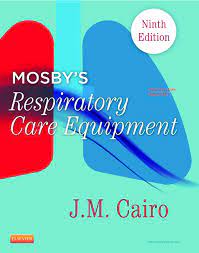Description
Test Bank For Mosbys Respiratory Care Equipment 9th Edition
Module 1: INTRODUCTION to BASIC RESPIRATORY SCIENCE
Basic Physics for the Respiratory Therapist
Principles of Infection Control
Module 2: MEDICAL GASES
Manufacture, Storage, and Transport of Medical Gases
Administering Medical Gases: Regulators, Flowmeters, and Controlling Devices
Module 3: AIRWAY MANAGEMENT
Airway Management Devices and ACLS
Humidity and Aerosol Therapy
Lung Expansion Therapy Devices
Module 4: ASSESSMENT
Assessment of Pulmonary Function
Assessment of Cardiovascular Function
Blood Gas Monitoring
Sleep Diagnostics
Module 5: CRITICAL CARE AND EXTENDED CARE DEVICES
Introduction to Ventilators
Mechanical Ventilators: General-Use Devices
Infant/Pediatric Ventilators
Chapter 02: Principles of Infection Control
MULTIPLE CHOICE
1. A 78-year-old man is going to be discharged today after having abdominal surgery several days ago. The nurse notices that the patient has a temperature of 101.5° F and has some tan secretions in his suture area. A specimen is sent to the laboratory. The results show the presence of gram-positive cocci. The statement that might explain this condition is which of the following?
a.
The antibiotic was ineffective.
b.
The patient was not compliant with therapy.
c.
It is normal to have secretions at the suture site.
d.
A health care-associated infection should be considered.
ANS: D
No antibiotic was mentioned in the scenario. There is no history of the patient receiving any medication for this problem, so compliance is not an issue with this situation. It is not normal to have secretions at a suture site.
PTS: 1 REF: Page 41
2. A nosocomial infection is best defined as a:
a.
respiratory system–borne pathogen.
c.
bacterial or viral organism.
b.
hospital-acquired pathogen.
d.
blood-borne pathogen.
ANS: B
A nosocomial infection is one that is acquired in a hospital setting. Respiratory system–borne pathogens and blood-borne pathogens can be acquired in the community.
PTS: 1 REF: Page 28
3. Infectious diseases are not usually caused by:
a.
ticks.
c.
viruses.
b.
bacteria.
d.
algae.
ANS: D
Algae do not cause infectious diseases. Infectious diseases can be caused by ticks, bacteria, and viruses.
PTS:1REF:Page 32, Table 2-3
4. Clinical microbiology is concerned with _____ the organism.
1. identifying
2. controlling
3. isolating
4. eradication of
a.
1 and 4
c.
1, 2, and 4
b.
2 and 3
d.
1, 2, and 3
ANS: D
Clinical microbiology addresses the identification, isolation, and control of pathogens, not their eradication.
PTS: 1 REF: Page 28
5. A prokaryotic, one-celled organism that ranges in size from 0.5 µm to 50 µm is usually classified as which of the following?
a.
Virus
c.
Bacterium
b.
Protozoan
d.
Retrovirus
ANS: C
This is the definition of a bacterium.
PTS: 1 REF: Page 28
6. When speaking about the morphology of bacteria, one is referring to its:
a.
size.
c.
function.
b.
shape.
d.
movement.
ANS: B
There are three ways to classify bacteria: by its shape, by staining, and by its metabolic characteristics. Size, function, and movement are not characteristics used to classify bacteria.
PTS: 1 REF: Page 28
7. Which of the following is a bacterium?
a.
Herpes simplex
c.
Pseudomonas aeruginosa
b.
Pneumocystis carinii
d.
Candida albicans
ANS: C
Pneumocystis carinii is a protozoan, herpes is a virus, and Candida albicans is a fungus.
PTS: 1 REF: Page 29
8. A sputum specimen is received in the microbiology laboratory. Gram staining and a microscopic examination reveal a paired, spherical, purple-stained organism. It can be reasonably assumed that this organism is which of the following?
a.
Gram-negative bacilli
c.
Gram-positive diplococci
b.
Gram-negative staphylococci
d.
Gram-positive bacilli
ANS: C
Diplococci are spherically shaped bacteria that occur in pairs; gram-positive organisms appear blue or violet. Gram-negative organisms have a red appearance from the counterstain. Staphylococci are cocci that occur in irregular clusters. Bacilli are rodlike organisms.
PTS: 1 REF: Pages 28-29
9. The word vibrio refers to:
a.
The many shapes bacteria can assume
b.
The erratic movement of bacteria
c.
Comma-shaped morphology
d.
Spirochete helical shape
ANS: C
Vibrio refers to comma-shaped bacteria.
PTS:1REF:Page 28, Figure 2-1
10. An organism that appears reddish-pink after Gram staining is usually called:
a.
gram-negative.
c.
non–acid-fast.
b.
gram-positive.
d.
acid-fast.
ANS: A
Gram-positive organisms stain blue or violet, whereas gram-negative organisms appear red from a counterstain of red dye safranin. Acid-fast is a different test.
PTS: 1 REF: Pages 28-29





Be the first to review “Test Bank For Mosbys Respiratory Care Equipment 9th Edition”